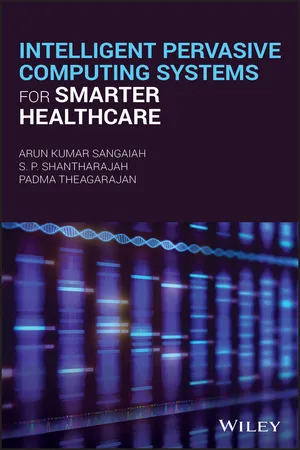
Intelligent Pervasive Computing Systems for Smarter Healthcare
Arun Kumar Sangaiah, S.P. Shantharajah, Padma Theagarajan
- English
- ePUB (mobile friendly)
- Available on iOS & Android
Intelligent Pervasive Computing Systems for Smarter Healthcare
Arun Kumar Sangaiah, S.P. Shantharajah, Padma Theagarajan
About This Book
A guide to intelligent decision and pervasive computing paradigms for healthcare analytics systems with a focus on the use of bio-sensors
Intelligent Pervasive Computing Systems for Smarter Healthcare describes the innovations in healthcare made possible by computing through bio-sensors. The pervasive computing paradigm offers tremendous advantages in diversified areas of healthcare research and technology.The authors—noted experts in the field—provide the state-of-the-art intelligence paradigm that enables optimization of medical assessment for a healthy, authentic, safer, and more productive environment.
Today's computers are integrated through bio-sensors and generate a huge amount of information that can enhance our ability to process enormous bio-informatics data that can be transformed into meaningful medical knowledge and help with diagnosis, monitoring and tracking health issues, clinical decision making, early detection of infectious disease prevention, and rapid analysis of health hazards. The text examines a wealth of topics such as the design and development of pervasive healthcare technologies, data modeling and information management, wearable biosensors and their systems, and more. This important resource:
- Explores the recent trends and developments in computing through bio-sensors and its technological applications
- Contains a review of biosensors and sensor systems and networks for mobile health monitoring
- Offers an opportunity for readers to examine the concepts and future outlook of intelligence on healthcare systems incorporating biosensor applications
- Includes information on privacy and security issues on wireless body area network for remote healthcare monitoring
Written for scientists and application developers and professionals in related fields, Intelligent Pervasive Computing Systems for Smarter Healthcare is a guide to the most recent developments in intelligent computer systems that are applicable to the healthcare industry.
Frequently asked questions
Information
1
Intelligent Sensing and Ubiquitous Systems (ISUS) for Smarter and Safer Home Healthcare
1.1 Introduction to Ubicomp for Home Healthcare
- Processing and sensing issues: Ubicomp systems sense and explore any knowledge about the context they operate in. The context refers to information that may be used to characterize the situation of an entity (Abowd et al., 1999) and may refer to user, physical, computational, and time context (Chen and Kotz, 2000). Sensors are fundamental to collect data from any environment; however, raw sensor data most of the times is not enough to provide useful high level context information. Therefore, raw data must be processed into more high level information constructs. For example, use the signal of Bluetooth Low Energy (BLE) beacons to estimate distances and calculate the location of devices; use a three‐axis accelerometer data time series to estimate the posture of a person (e.g. fall, run, walk, stand, lay, sit).
- Integration and management issues: The deployment of COTS systems in the same AAL household has two fundamental concerns: (i) The standard interconnection and orchestration of devices for enabling seamless interactions and automation. The integration of COTS systems could be achieved through the use of local or edge middleware frameworks such as openHAB or Simple Network Management Protocol (SNMP)‐like tools. Another important trend is the integration through cloud services that glue together heterogeneous deployed systems. (ii) The secure or safe integration of COTS systems that are developed by independent vendors without integration concerns, thus not planned to be deployed together. These systems must coexist in the same ecosystem without causing crossed malfunctions. For example, a drug dispenser (DD) periodically issuing a sound alarm until the user takes a prescribed medicine could suffer a functional interference from an entertainment system that simultaneously could be playing a movie or TV series. When two or more systems compete for a shared medium (e.g. user attention), that may cause a behavior interference (e.g. prevent user from taking medication).
- Communication and coordination issues: Home healthcare COTS systems play an important role in the deployment of AAL smart spaces. However, it is important to guarantee agile and affordable deployment mechanisms without preinstalled communication infrastructures. Wireless mesh technologies are therefore fundamental to enable the growth and widespread of such ubiquitous systems. Most of smart spaces use body and environmental sensor motes deployed together without the need for fixed infrastructures. These modules communicate through heterogeneous wireless technologies, thus typically requiring bridging gateways equipped with multiple shields [e.g. ZigBee, Bluetooth (BT), Wi‐Fi, General Packet Radio Service (GPRS)], thus enabling simple and adaptable wireless topologies. These agile solutions allow easy data collection and storage for further analytical treatment and consultation by healthcare providers and also control interactions and trigger real‐time alerts in dangerous situations.
- Intelligence and reasoning issues: The representation of context information is fundamental in AAL systems. It is necessary to use knowledge representation models and tools that enable to reason about the premises and conditions about the user and its surroundings. Such tools may use typically deductive or inductive processes. This section proposes the use and combination of both types of reasoning. The former, deductive reasoning, uses the Semantic Web Rule Language (SWRL) that combines OWL and Rule Markup Language (RuleML) to allow the definition of Horn‐like rules. These rules specify a set of state conditions related by boolean operators that will allow the inference of other states or terms. The latter, inductive reasoning, uses machine learning (ML) algorithms that typically capture/learn patterns on sets of observations (training sets) and then generalize those patterns to classify new observations. The remaining sections will revisit each of these key research issues on separate sections. For every topic, the respective section details one or two example project outcomes related with the research solutions typically applied to home healthcare use cases. Section 1.2 addresses the aspects related with processing raw data sensor signals to ...